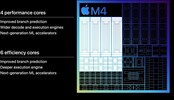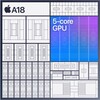Apple M4 (10 cores) vs Apple A18
Apple M4 (10 cores)
► remove from comparison
The 10-core Apple M4 is an impressively fast ARM architecture processor (SoC) sporting 4 performance and 6 efficient CPU cores along with a 16-core neural engine and a 10-core GPU with hardware RT support and other modern features. On-package 7500 MT/s LPDDR5x RAM, USB 4 support and Thunderbolt 4 support are onboard as well, as are Wi-Fi 6E and Bluetooth 5.3.
The M4 debuted in May 2024 as part of an iPad launch event; its 4 performance cores run at up to 4.4 GHz, representing a healthy improvement over the M3 (10-core GPU) and its 4.06 GHz top clock speed. Besides, this new chip also has 6 efficient cores at its disposal that run at up to 2.9 GHz. The M3 had to make do with 4 performance cores and 4 efficient cores, for reference.
Architecture and Features
The new CPU cores run at faster clock speeds than what the M3 was capable of while also featuring some minor architectural improvements. A heavily customized version of ARM's v9.4-A microarchitecture is reportedly employed here. The M4 comes with on-package LPDDR5x-7500 RAM (120 GB/s) whereas the M3 was limited to 6400 MT/s. The updated NPU delivers up to 38 TOPS of performance for AI workloads.
Performance
In 2024 iPad Pros, the 3 nm chip is 10% to 20% faster than the M3 (10 GPU cores) in both multi-thread and single-thread short-term workloads. It also delivers about 10% higher multi-thread performance than the 9-core M4. This puts the 10-core part on an equal footing with the Ryzen 7 7745HX, Core i7-13705H and other higher-end x86 processors released in 2023 and 2024.
iPad Pros come with no active cooling solution however Mac minis and MacBook Pros do have one and the latest iMacs probably do as well. As our Fall 2024 Mac mini review shows, the M4's short-term performance doesn't benefit much from the presence of a fan, however its sustained performance benefits tremendously.
Graphics
The M4 GPU (10 cores) has hardware support for ray tracing as well as mesh shading and other modern technologies. It supports external displays with resolutions as high as 8K.
The graphics adapter runs at higher clock speeds than what the (otherwise identical) 10-core GPU built into the 9-core M4 can muster. As our Mac mini 2024 review confirmed, its performance is good enough to run many 2023 and 2024 games at 1080p on low or medium quality settings.
- Сyberpunk 2077 2.1 Phantom Liberty (1080p, Med): 28 fps
Much like it is with CPU performance, M4-powered iPad Pros will be much slower in long-term GPU-intensive workloads than iMacs, Mac minis and MacBook Pros due to the lack of proper cooling.
Power consumption
This specific M4 chip is found in 2024 iPad Pros, 2024 iMacs, 2024 Mac minis and 2024 MacBook Pros. Within the thin metal cases of the iPads - no active cooling - the chip's sustained power consumption hovers in the 4 W - 5 W area, with short-term peaks of up to 14 W possible. However, Mac minis and MacBook Pros do have an active cooling solution (and the new iMacs probably do, too) meaning the power consumption figures are several times higher. In our Fall 2024 Mac mini review, the SoC consumed 30 W to 40 W when under high loads.
The M4 is built with a "second generation" 3 nm TSMC process which is still cutting-edge as of late 2024.
Apple A18
► remove from comparison
The Apple A18 is a powerful smartphone processor and formal successor to the A16. This new member of the Apple A processor series debuted in September 2024 alongside the iPhone 16 and iPhone 16 Plus; it features 2 performance cores and 4 efficient cores along with a 35 TOPS NPU and the 5-core A18 GPU.
The chip is normally paired with 8 GB of RAM. It is said to be in large part based on the v9.2A ARM microarchitecture for near-Apple M4 IPC. 5G, Wi-Fi 7, Bluetooth 5.3, various satellite navigation systems and NFC are all supported here.
The more expensive A18 Pro SoC has the same 2 P-cores and 4 E-cores running at slightly higher clock speeds; its graphics adapter is on the other hand significantly faster than what the A18 has. Another crucial little detail is that USB 3.x support is either missing, or disabled somehow on the A18 for USB 2.0 speeds only whereas the A18 Pro has no such issue.
Performance
Multi-threaded benchmarks put it in the same ballpark as the Snapdragon 8 Gen 3 and the Dimensity 9300. As expected from Apple, the A-series processor delivers breathtaking single-thread performance that just about matches the significantly more power-hungry Apple M3 chip. This suggests the P-cores can almost hit the 4 GHz mark when required.
Graphics
Like any modern graphics adapter, the 5-core A18 GPU is RT-enabled. It delivers benchmark scores that are most comparable to the G715 MP11 and the G615 MP6.
Power consumption
It appears the chip is able to briefly consume up to about 9 W when under high load, with average sustained power consumption figures hovering around 3-4 W.
The pretty modern TSMC N3E manufacturing process makes the A-series chip very power-efficient, as of late 2024.
| Model | Apple M4 (10 cores) | Apple A18 | ||||||||||||||||||||||||||||||||||||||||||||||||||||
| Series | Apple M4 | Apple Apple A-Series | ||||||||||||||||||||||||||||||||||||||||||||||||||||
| Series: Apple A-Series |
|
| ||||||||||||||||||||||||||||||||||||||||||||||||||||
| Clock | 2890 - 4464 MHz | <=3800 MHz | ||||||||||||||||||||||||||||||||||||||||||||||||||||
| L2 Cache | 4 MB | 4 MB | ||||||||||||||||||||||||||||||||||||||||||||||||||||
| Cores / Threads | 10 / 10 4 x 4.5 GHz Apple M4 P-Core 6 x 2.9 GHz Apple M4 E-Core | 6 / 6 2 x Apple A18 P-Core 4 x 4.0 GHz Apple A18 E-Core | ||||||||||||||||||||||||||||||||||||||||||||||||||||
| TDP | 40 Watt | |||||||||||||||||||||||||||||||||||||||||||||||||||||
| TDP Turbo PL2 | 40 Watt | 9 Watt | ||||||||||||||||||||||||||||||||||||||||||||||||||||
| Transistors | 28 Million | |||||||||||||||||||||||||||||||||||||||||||||||||||||
| Technology | 3 nm | 3 nm | ||||||||||||||||||||||||||||||||||||||||||||||||||||
| Features | Unified Memory LPDDR5X-7500 (120 GB/s), 16-Core Neural Engine, Media Engine (Encoding / Decoding: H.264, HEVC, ProRes, ProRes RAW, AV1 Decoding only) | 16-core Neural Engine, USB 2.0 (480 Mbps) | ||||||||||||||||||||||||||||||||||||||||||||||||||||
| iGPU | Apple M4 10-core GPU | Apple A18 GPU | ||||||||||||||||||||||||||||||||||||||||||||||||||||
| Architecture | ARM | ARM | ||||||||||||||||||||||||||||||||||||||||||||||||||||
| Announced |
Benchmarks
Average Benchmarks Apple M4 (10 cores) → 100% n=8
Average Benchmarks Apple A18 → 72% n=8
* Smaller numbers mean a higher performance
1 This benchmark is not used for the average calculation













